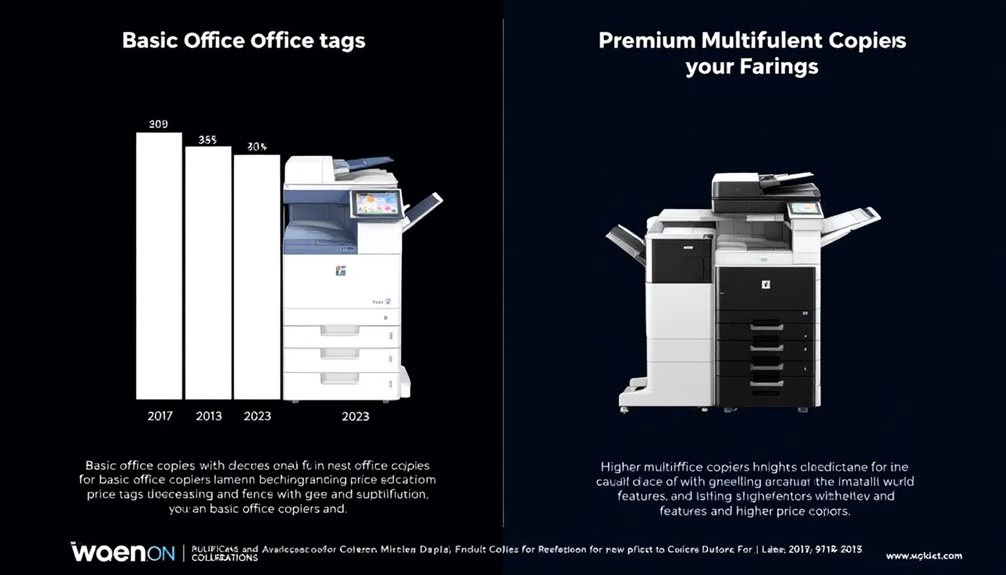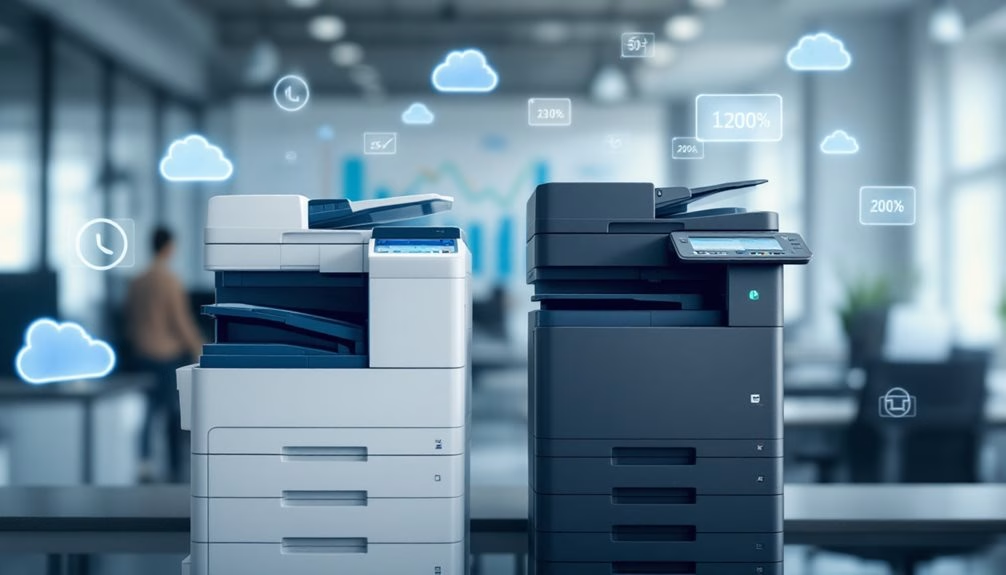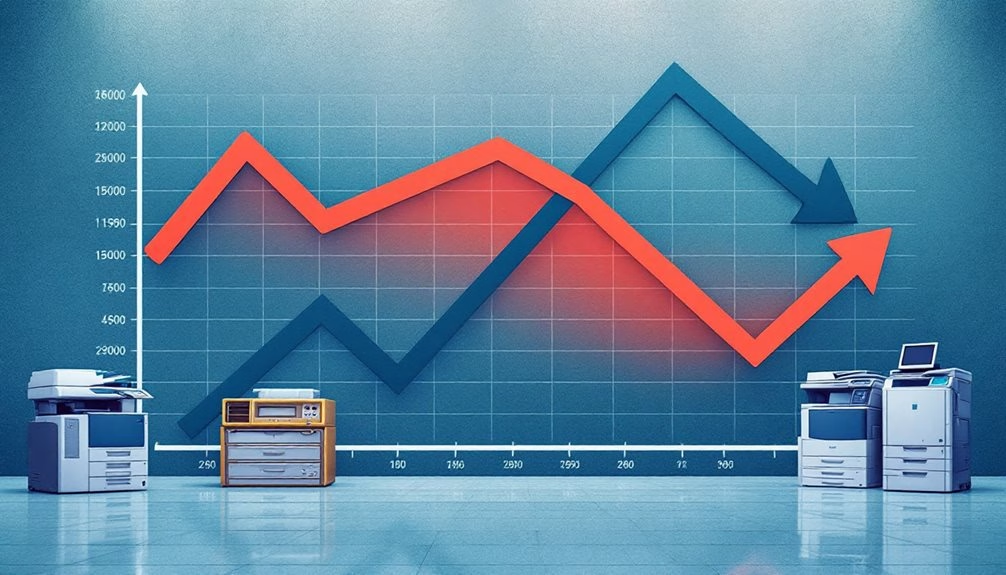We’ve witnessed a remarkable evolution in copier pricing over the past decade. What once represented a significant capital investment has transformed into diverse pricing models tailored to businesses of all sizes. The market has split dramatically between budget-friendly options and premium systems packed with advanced features. This bifurcation, combined with the rise of subscription-based services, has fundamentally changed how organizations approach their document management costs. What’s driving these shifts might surprise you.
Expert Highlights
- Entry-level copier prices have decreased while premium models with advanced features have become more expensive.
- Pricing models shifted from one-time purchases to subscription-based and cost-per-page services.
- Market consolidation allowed major manufacturers to maintain higher pricing margins.
- Environmental regulations and compliance requirements increased manufacturing costs across the industry.
- Digital transformation expanded copier functionality beyond printing to workflow solutions, justifying premium pricing.
The Bifurcation of Entry-Level and Premium Copier Pricing

While examining the evolution of copier pricing over the past few decades, we’ve observed a clear bifurcation between entry-level and premium models. Entry-level prices have steadily decreased, making basic copying accessible to small businesses and home offices.
Meanwhile, premium copier prices have increased as manufacturers integrate advanced features like cloud connectivity, enhanced security, and sophisticated finishing options. This pricing divergence reflects our community’s varied needs.
Premium copiers command higher prices today as they evolve beyond mere document reproduction into sophisticated business workflow hubs.
Your business position determines which trend affects you most. Small operations benefit from affordable basic models, while enterprises investing in premium systems gain productivity advantages that offset higher costs.
This market segmentation guarantees everyone finds solutions matching both requirements and budget. Businesses choosing premium multi-function printers can achieve lower total ownership by 30% compared to maintaining multiple single-function devices.
How Digital Transformation Reshapes Copier Value Propositions

The pricing landscape we’ve explored reflects a more fundamental shift occurring within the industry.
Digital transformation has redefined what we value in modern copiers. They’re no longer just document reproduction machines but integrated workflow solutions.
We’re paying for connectivity, cloud capabilities, and cybersecurity features that weren’t considerations a decade ago.
Our copiers now serve as digital hubs where physical documents enter our digital ecosystems.
Traditional cost-per-page models have evolved into subscription-based services where we’re investing in productivity rather than hardware alone.
The future belongs to machines that seamlessly bridge our physical and digital workspaces.
Modern multifunction devices now offer cloud storage integration that enhances document accessibility while maintaining advanced security protocols.
Environmental Regulations and Their Impact on Manufacturing Costs

Environmental regulations have dramatically reshaped the copier manufacturing landscape since the early 2000s, driving significant cost implications throughout the supply chain.
We’ve witnessed manufacturers investing heavily in redesigning products to meet RoHS and WEEE directives, eliminating hazardous materials like lead and mercury. These compliance costs inevitably transfer to pricing structures.
Energy efficiency requirements—particularly Energy Star standards—have necessitated more sophisticated components and testing protocols, further elevating production expenses.
Meanwhile, sustainable packaging mandates and carbon footprint reduction goals have transformed logistics operations.
For us in the industry, these regulatory demands represent both challenge and opportunity as we balance environmental stewardship with competitive pricing in today’s eco-conscious marketplace.
These challenges underscore why many organizations have turned to Managed Print Services to optimize their printing infrastructure while maintaining environmental compliance.
The Shift From Purchase to Service-Based Pricing Models

In examining the copier industry’s evolution, we’ll explore how the Cost-Per-Page Revolution fundamentally altered pricing structures from the 1990s onward.
This shift allowed businesses to pay for actual usage rather than equipment, creating predictability in budgeting while transferring maintenance responsibilities to vendors.
The Hardware Lease Transformation complemented this trend by converting capital expenditures into operational costs, making advanced copying technology accessible to organizations with limited upfront resources.
Modern businesses benefit from flexible leasing options that adapt to both budget constraints and operational requirements while eliminating concerns about equipment obsolescence.
Cost-Per-Page Revolution
During the late 1990s and early 2000s, a seismic shift occurred in how businesses acquired and paid for copying equipment. The cost-per-page model emerged as a revolutionary approach, allowing us to pay only for what we use rather than investing heavily upfront.
| Year | Traditional Model | Cost-Per-Page Model |
|---|---|---|
| 1995 | 100% market share | 0% adoption |
| 2000 | 82% market share | 18% adoption |
| 2005 | 63% market share | 37% adoption |
| 2010 | 41% market share | 59% adoption |
| 2015 | 28% market share | 72% adoption |
We’ve embraced this transformation together, seeing our copying costs become predictable monthly expenses instead of capital investments.
Hardware Lease Transformation
The cost-per-page model set the stage for an even broader revolution in copier acquisition strategies.
We’ve witnessed traditional ownership giving way to service-based leasing arrangements that bundle hardware, consumables, and maintenance into predictable monthly payments.
This transformation speaks to our collective desire for financial flexibility. Instead of committing capital to depreciating assets, we’re now investing in scalable solutions that grow with our organizations.
The hardware lease model eliminates unexpected repair costs while ensuring we always have access to current technology.
For many of us, this shift represents more than pricing—it’s about joining a community that values outcome over ownership.
Market Consolidation Effects on Competitive Pricing Strategies

Market consolidation within the copier industry has dramatically reshaped competitive pricing strategies since the early 2000s.
We’ve watched as major players like Xerox, Canon, and HP absorbed smaller competitors, creating pricing power that’s transformed our market.
When fewer companies control the landscape, we’ve noticed they can maintain higher margins without sacrificing market share.
Yet, we’re also seeing counterintuitive effects—in some segments, consolidation has sparked price wars as remaining giants fight for dominance.
For us in the industry, this means adapting to a new reality where competitive pricing now depends more on service bundles and software integration than hardware costs alone.
Our commitment to transparent pricing has helped businesses navigate these market shifts while still receiving premium equipment solutions that enhance productivity.
Regional Pricing Disparities in Global Copier Markets
While global manufacturing standards have largely standardized copier technology worldwide, regional pricing disparities remain one of the most puzzling aspects of our industry.
We’ve tracked how identical models can vary by up to 40% between markets like North America and Southeast Asia. These differences stem from complex variables including import tariffs, distribution infrastructure, and local competition intensity.
What’s fascinating is how we’re seeing these gaps narrow in digitally-connected markets but widen in emerging economies.
Digital markets converge while emerging economies experience widening price disparities—creating a fascinating two-speed global pricing landscape.
For those of us steering through international procurement, understanding these regional patterns isn’t just interesting—it’s essential for strategic purchasing decisions that keep us competitive in our respective markets.
Frequently Asked Questions
How Have Extended Warranty Costs Changed Alongside Copier Prices?
We’ve noticed extended warranty costs usually follow copier prices. They’ve generally decreased, but they’re now a higher percentage of the total purchase, making them feel like a bigger investment for our teams.
What’s the Typical Depreciation Rate for Commercial Copiers?
We’ve found most commercial copiers depreciate 20-30% annually in the first three years, slowing to 10-15% thereafter. You’ll see greater value retention with premium brands.
How Do Refurbished Copier Prices Compare to New Models?
We’ve found refurbished copiers typically sell for 40-60% less than new models, giving you great value while still offering reliable performance. Many come with warranties to protect your investment.
Will Quantum Computing Impact Next-Generation Copier Technology Pricing?
We don’t expect quantum computing to markedly impact copier pricing soon. While it’ll eventually revolutionize processing capabilities, consumer-level copier tech won’t incorporate quantum elements in our immediate price considerations.
How Do Seasonal Pricing Fluctuations Affect Copier Purchase Timing?
We’ve noticed copier prices drop during back-to-school seasons and fiscal year-ends. Let’s time our purchase during these periods—you’ll join other savvy buyers who save 10-15% through strategic timing.
Expert Final Thoughts
We’ve witnessed remarkable evolution in copier pricing over the last decade. While entry-level models have become more accessible, premium devices command higher prices for advanced capabilities. The industry’s shift to subscription and service-based models has fundamentally changed how we invest in document solutions. As consolidation continues and environmental standards tighten, we’ll see these pricing trends further diverge across global markets.
About the Expert
Rafael M.
CEO of JR Copier
With over 35 years of hands-on experience in the copier and office printer industry, Rafael brings unparalleled expertise to every client interaction. His journey from service technician to CEO provides him with comprehensive understanding of all aspects of the business.
Areas of Expertise: Copier and printer sales, equipment leasing strategies, maintenance solutions, and managed print services. Rafael's deep industry knowledge ensures clients receive expert guidance, transparent pricing, and exceptional service for all their office equipment needs.
Connect on LinkedIn